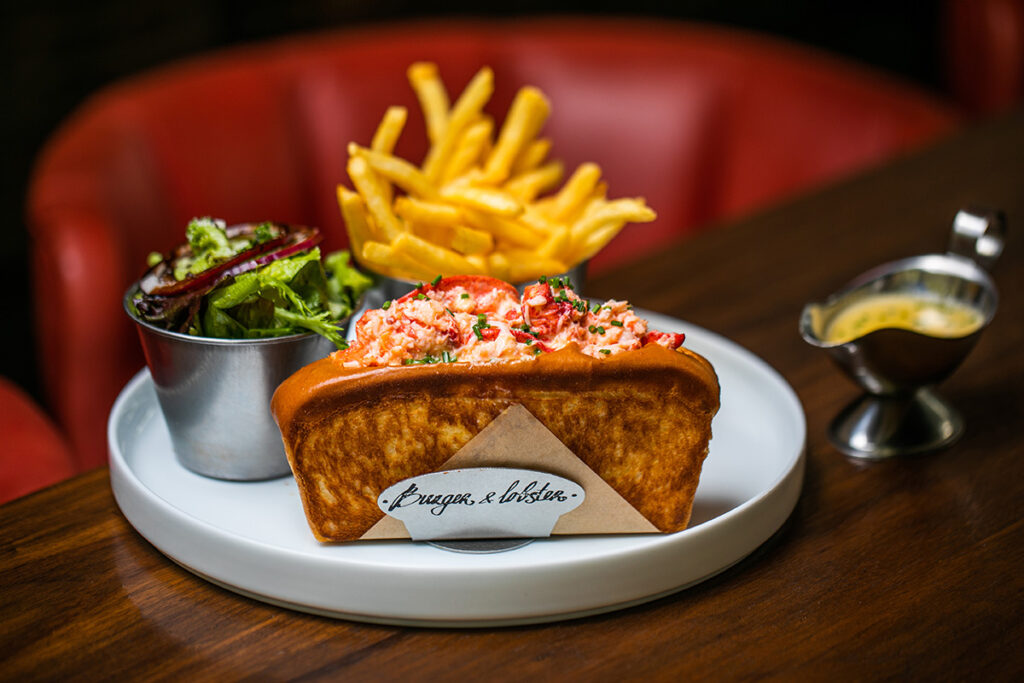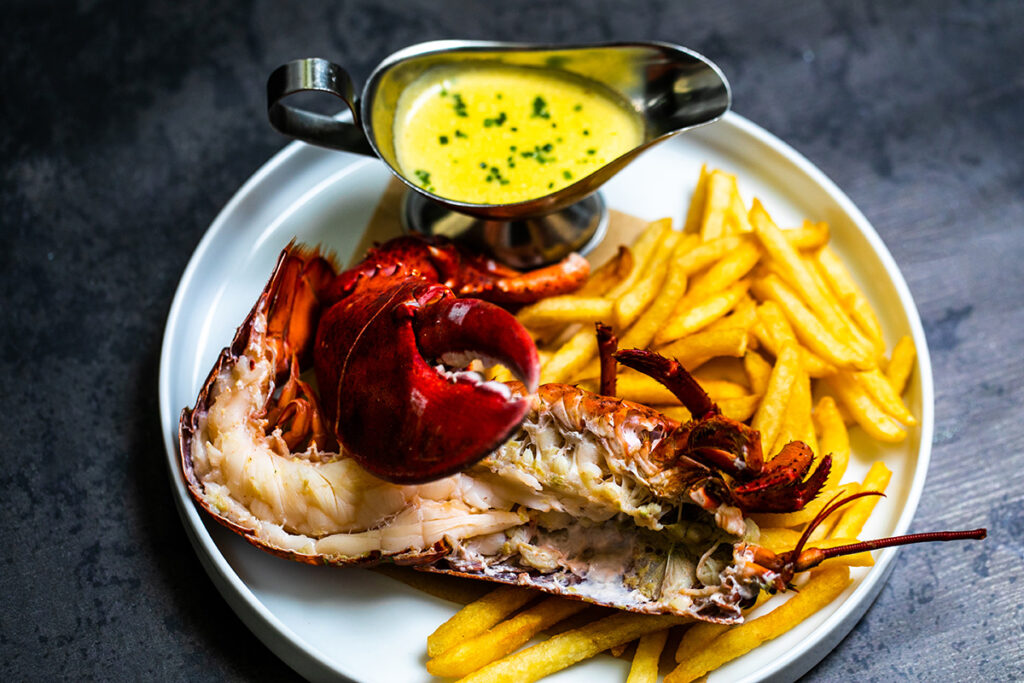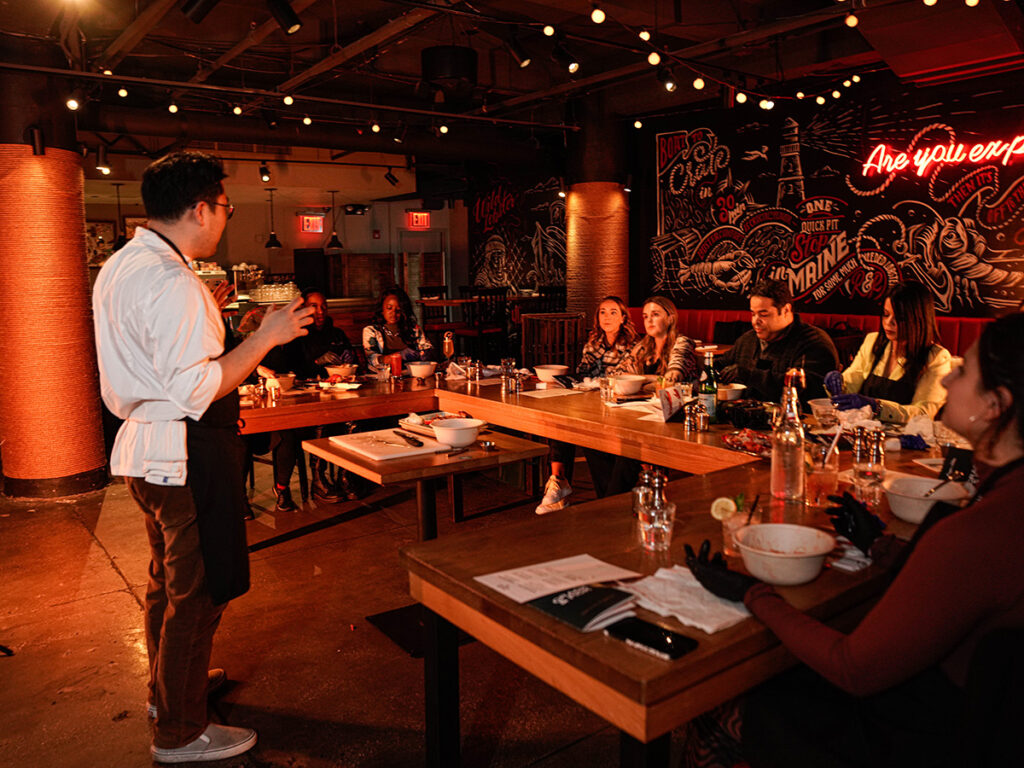Oh, the mighty lobster. We love it mixed with mayo and stuffed into a buttery bun or just simply taken out of the shell and dipped in clarified butter. And while we like to enjoy it from restaurants and food trucks, we wouldn’t claim to be experts on cooking the crustacean at home. Enter Chef Danny Lee, the executive chef of Burger & Lobster USA. In May, he began teaching a lobster masterclass at the New York Burger & Lobster locations, so as to help home cooks learn how to break down a lobster (which attendees use to craft a lobster roll during this class).


“People love eating [lobster], but a lot of people don’t know how to break it down,” Lee says. “Everybody has bits and pieces that they read somewhere or heard somewhere, but they’ve never really gotten to the nitty gritty of it. And so after years of breaking down lobsters at Burger & Lobster, I figured, you know what, let’s share some of our knowledge.”
After attending a media preview of the masterclass back in April, we wanted to sit down with Lee and pick his brain about how to properly cook a lobster at home, what parts of the lobster you shouldn’t eat and how to utilize the shell after you’ve eaten all that sweet, sweet meat.
Q: For home cooks who want to cook a lobster for the first time, what do they need to know?
A: The biggest thing is that you want to pick a fresh lobster. You want a lobster that’s going to be very active when you pick him or her up—the claws are flaring up, the tail’s snapping a bit. You want it to be active. Because if they’re kind of drooping a little bit when you pick them up that means that the meat is not going to be as good sometimes.

So once you’ve picked out a good lobster, you want to make sure before you’re cooking it that it’s stored in a nice, cold, wet environment because they’ll be precious in that place. When they’re dry, they get stressed, so when you stress out the lobster, the meat actually starts to kind of break down a little bit and when you do cook it, it turns out a lot mushier than you’d want it to be.
Once you’ve done that, you want to have some boiling water in a pot that’s going to fit that whole lobster. You can add salt to the water, but I tend to find that lobsters, since they’re coming out of saltwater, tend to have a fairly decent amount of sodium already. But you can add a little bit more so you get that full flavor.
Then, before you cook the lobster, you want to give it a quick death. It’s not the most pleasing part, but you know. You take the knife, and you stab it through the head and come straight down real quick, so that you can get an instant kill. And then, once the water is boiling, that’s when you want to put the lobster in. Depending on the size of the lobster, a general rule of thumb is like five to seven minutes per pound. But each lobster is a little bit unique, a little bit different. You have to gauge that, and the best way to determine whether your lobster is cooked or not is to have a thermometer tell you. Ideally, cook it to about 140 degrees internal temperature in the thickest part. This is for steaming.
The best way to grill it and still have that tenderness is to pre-steam. So you’re going to cook it till the meat is still translucent and the shell is getting that red tinge, and then you split it in the middle and you pick out the tomalley, which is like the liver and pancreas of the lobster, out of that body cavity. And then you can finish it right on the grill. The claws you can just literally leave in the shell and put them right on the grill and let it finish off. It actually turns into its own little oven, in a sense.
Is there anything specific home cooks need to know about lobsters and their anatomy before they begin cooking?
If they need to know anything, it’s where most of the meat is going to be, so most of the meat of the lobster is going to sit in the tail, the claws and the knuckles. There is some body meat underneath the tomalley, and also the leg meat. For the leg meat, you have to take individual legs out and poke through and squeeze it out or you could roll the meat out of the shells. But if you know where you’re going to get your meat, then you know how to break a lobster down a lot easier.
Is there any part of a lobster that you shouldn’t eat?
You don’t really want to eat the gills. So, that’s the part where, if you lift up that cover shell of the body, on the side, you’ll see outside of the body cavity are the gills and those are not really edible. It’s really like the lobsters’ filter, so you don’t want to eat any of that portion. And then the tomalley is sort of controversial. People who really love lobster, they love tomalley. There is some of that sweetness to it, and a lot of people eat crab tomalley, as well. But technically, there’s some reports that show it’s really not that good for you. You can get sick from eating it. People who love it will take that risk, but most people will stay away from that.

What is the most complicated part about cutting into a lobster, and what should home cooks who are new to cooking lobster keep in mind?
The most complicated part is actually not trying to slip when you’re cutting. You want to have a firm grip on that lobster and a firm grip on your knife when you’re cutting through it. There is that little point where the tail meets the head, or the carapace, and you can point your knife toward that little indent, and that’ll give you a little bit more of a grip to cut into it in one nice, smooth motion. So you’ll need a little bit of force there, but obviously when you’re pushing down on that knife you want that knife to be not near your fingers.
What do you think is the most underutilized part of the lobster?
I think most home cooks will just be like, “Okay, we’ve eaten this and now it’s done.” And then they won’t really go into the body, the legs or the body cavity. But what you can do with that is use it to make soup. Like, we use all lobster bodies to make our lobster bisque at Burger & Lobster, and to do that you have to take off the top of that like thin covering shell, and you want to scrape the gills off and whatever is left over there, and you leave the body meat in there and if you leave the leg meat in there as well, then it’ll be a little bit more flavorful. You also can make a lobster stock out of it, or you can use it to make sauces. And if you get a female lobster, you can also get lobster roe, and you can use that lobster roe to make sauces or add some more flavor to your stock as well.
Feature photo by Byron Johnson.



